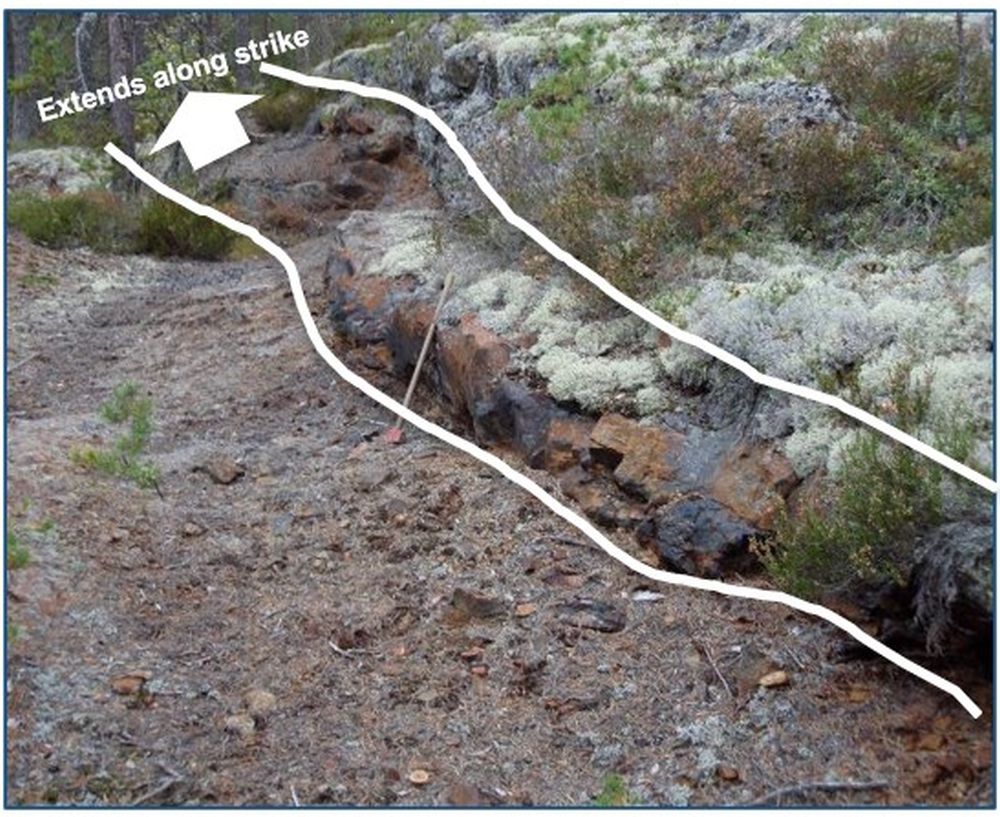Sanna
EMX’s Sanna Project sits 10 km southwest of Örnsköldsvik and targets a conduit-style magmatic nickel sulfide system. There has been no nickel exploration in this area since the 1940’s and low-resolution public datasets hid prospective target areas from previous explorers. The Sanna Project displays all of the key characteristics of a fertile magmatic system, including ultramafic rocks, lithologies formed during a period of continental rifting, the presence of cumulate horizons, sinuous aeromagnetic anomalies, sulfur-rich country rocks, and visible sulfides (massive and net-textured). The presence of xenoliths and partial melting in historical drill core provide evidence for a dynamic and high-heat conduit system.
The Förnätra prospect is an outcropping massive sulfide injection feature. Historical Boliden drillholes from 1944 intersected 0.95m @ 1.21% Cu, 0.46% Ni, 598 ppm Co, 0.095 g/t Pt, 0.25 g/t Pd (DDH5, from 26.5m) and 1.85m @ 0.96% Cu, 0.52% Ni, 619 ppm Co, 0.019 g/t Pt, 0.43 g/t Pd (DDH9, from 14.4m)1. At the time, the magmatic sulfide model was not understood and Boliden did not recognize that this injection feature was not the target, but rather a feature with which to vector back towards the parent conduit. EMX fieldwork in 2023 revealed the injection feature is bordered by a narrow fine-grained ultramafic dike that displays chalcopyrite veinlets. Furthermore, net-textured sulfides were observed in the historical dump piles indicating in-situ crystallization of an immiscible sulfide liquid and suggesting that this exposure of the injection feature may be proximal to the parent conduit. EMX soil surveys highlighted an anomalous area to the northeast of the Förnätra prospect and groundtruthing the anomaly revealed a previously unknown second injection feature. A chalcopyrite-rich and a chalcopyrite-poor sample from the second injection feature assayed 1.29% Cu, 0.40% Ni, 0.26 g/t Pd+Pt and 0.44% Cu, 0.60% Ni, 0.20 g/t Pd+Pt, respectively2.
1 1944 Boliden historic drill core was sampled by EMX in 2022 and sent to the ALS Lab in Malå, Sweden for crushing and splitting. The elements Pt, Pd and Au were analyzed via fire assay, and multi-element geochemistry was determined via 4-acid digestion (ALS techniques PGM-ICP23 and ME-MS61). True thickness of intercepts unknown.
2 EMX rock chip samples are collected in accordance with industry standard best practices. Samples are submitted to ALS in Malå, Sweden where they are prepped before being shipped to ALS in Galway, Ireland for analysis. Accredited control samples (blanks and accredited standards) are inserted into the sample suite regularly. Samples are dried, weighed, crushed (70% < 2mm), and riffle split into two fractions. One is retained (coarse reject) and the other is pulverized to 85% < 75µm. Pulps are analyzed by ultra-trace ICP-MS (ME-MS61) and ICP-AES Au-Pt-Pd (PGM-ICP23). Over detection limit samples are reanalyzed using ore grade ICP-AES by aqua regia (ME-OG62).
Maps
Photos

 Click to Enlarge
Click to Enlarge
 Click to Enlarge
Click to Enlarge
 Click to Enlarge
Click to Enlarge